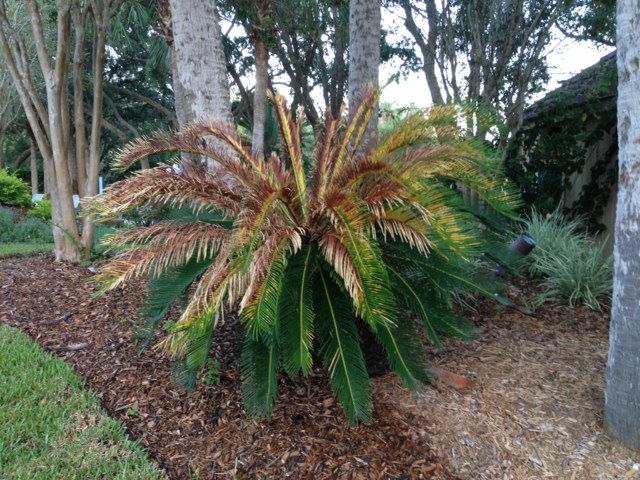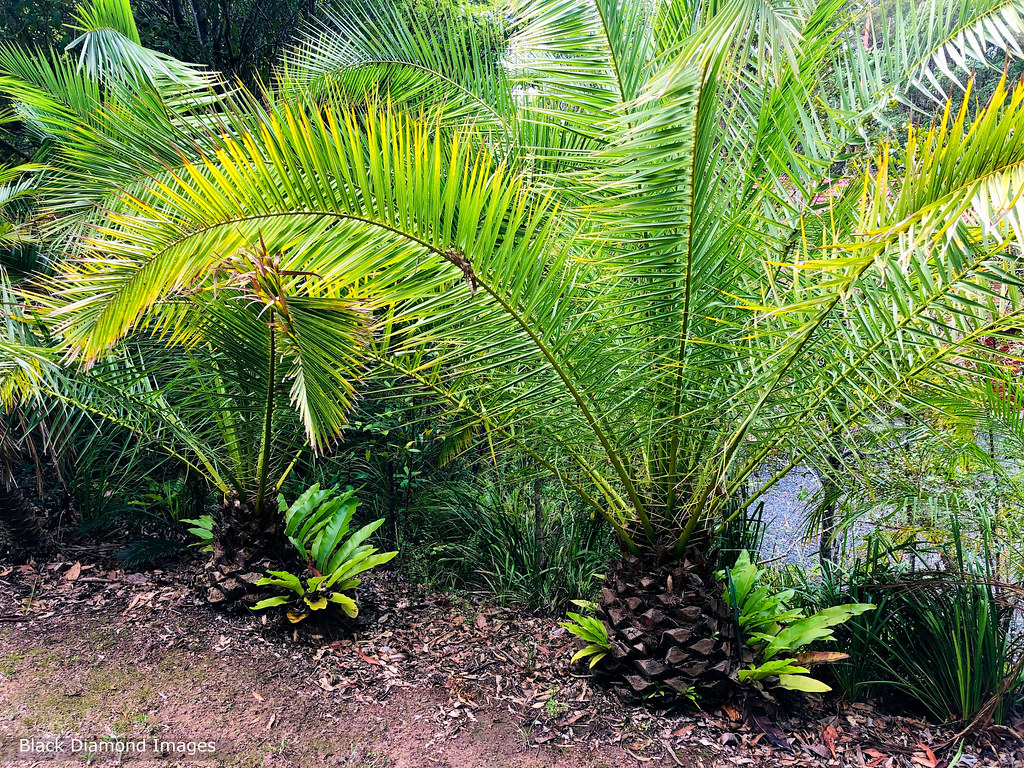Sago palms grow slowly, about 1-2 inches per year. This slow-growing palm species is native to tropical regions of Asia but is commonly grown in other parts of the world as an ornamental plant.
The sago palm, also known as cycas revoluta, is a popular choice for landscape design due to its aesthetic, hardiness, and low maintenance requirements. It is a cycad, a type of primitive, seed-producing gymnosperm plant that has survived on Earth for over 200 million years.
Sago palms have a distinctive look with their feathery, stiff fronds that grow upward from a central trunk, but it takes time to develop their full-size potential. They can live for decades, reaching heights of 10 feet or more in some cases. Despite their beauty, it is essential to note that all parts of the sago palm are toxic to animals and humans and should be kept out of reach.

Credit: nwdistrict.ifas.ufl.edu
What Are Sago Palms?
Sago palms are small evergreen trees that belong to the Cycadaceae family. These palms are not true palms but rather cycads, closely related to conifers and ginkgo. Sago palms are originally from tropical Asia, but they are found all over the world today.
These amazing plants are well-known for their natural beauty and as ornamentals. We will explore the vital aspects of sago palms, including their growth rate, common features, and commercial importance.
Brief Introduction To Sago Palms And Where They Are Commonly Found
- Sago’s palms grow extensively in tropical areas and in Japan, Thailand, and malaysia, and are now found throughout Spain, Italy, Greece, and the United States.
- There are several types of sago palms, each with its unique morphology and adaptation.
- Sago palms are cultivated for food, medicine, and as an ornamental plant due to their striking appearance.
- These slow-growing plants can live up to hundreds of years if given the right care.
Popularity Of Sago Palms As Ornamental Plants
- Sago palms are popular in landscaping due to their regal look, tropical appeal, and the fact that they look great as potted plants.
- They require minimal maintenance and attention, making them an ideal plant for many gardeners.
- They are widely used in interior decorations, adding an exotic touch to any room.
- Sago palms have a low risk of pest infestation, making them an ideal choice for organic gardening.
Sago Palm Growth Rate
- Sago palms are slow-growing plants, taking anywhere from 10-15 years to grow to a height of a few feet.
- They grow from a central cluster of fronds and are dioecious, meaning that male and female flowers occur on separate plants.
- The primary mode of reproduction is through offsets which take root from plantlets that emerge at the base of the parent plant.
- Although slow-growing, sago palms can grow to be quite tall, with some specimens reaching 20 feet in height.
Sago palms are fascinating plants that are well-loved for their striking appearance and low-maintenance needs. They are slow-growing but eventually grow into beautiful specimens that are perfect for landscaping and indoor decorations. Given the right care, sago palms can live for centuries, which only adds to their appeal.
These plants are a perfect choice for both novice and experienced gardeners alike, and anyone looking to add a touch of tropical charm to their home decor.
The Importance Of Understanding Sago Palm Growth Rates
Sago palms are a classic staple in many landscapes and gardens, but their growth rates can vary dramatically. Understanding growth rates and their impact is crucial for those who care for these beautiful plants. Here’s why:
Brief Explanation Of Why Sago Palm Growth Rates Matter
Plain paragraph:
Sago palms thrive in warm, sunny locations, and can grow rapidly in optimal conditions. However, growth rates can vary based on a variety of factors, including age, climate, and soil quality. Understanding these factors can help gardeners predict and manage growth, ensuring the plant’s health and longevity.
Bullet points:
- Sago palms can take several years to reach maturity, and growth rates typically slow down as the plant ages.
- Excessive water, poor drainage, and extreme temperatures can stunt or kill sago palm growth.
- A lack of nutrients, particularly nitrogen, can also slow growth rates.
- Sago palms are prone to insects, which can impact growth by damaging leaves and stems.
- Neglecting to remove dead or damaged leaves can significantly hinder sago palm growth.
How Sago Palm Growth Rates Affect Plant Owners
Plain paragraph: Understanding sago palm growth rates is essential for plant owners because it allows them to anticipate and respond to changes in the plant’s health, size, and shape. This knowledge is crucial not just for the esthetics of the plant, but also for its overall health and ability to weather climate conditions.
Bullet points:
- Monitoring growth rates can help plant owners detect problems earlier, such as insect infestations or nutrient deficiencies, before they become severe.
- Anticipating growth rates can also help plant owners plan for the future, such as when to prune branches or transplant the plant to a larger pot.
- For farmers or florists who plan to grow sago palms for commercial purposes, understanding the growth rate and its management is necessary for profit maximization and overall plant health.
Sago palms can be beautiful additions to any landscape or garden, but they require careful attention to their growth rates to thrive. Understanding these growth rates and their impact on the plant’s health is crucial for plant owners to keep their sago palms healthy and vibrant for years to come.
How Fast Do Sago Palms Grow?
Discover The Shocking Growth Rate Of Sago Palms!
Have you ever wondered how quickly sago palms can grow? If you’re thinking about adding these stunning plants to your garden, it’s essential to know their growth rates. Here’s a detailed overview of sago palm growth rates and how they compare to other plants.
Detailed Overview Of Sago Palm Growth Rates
Sago palms are slow growers, taking around 10-15 years to reach maturity. However, once they’ve matured, these plants can grow up to 3 feet tall and 3 feet wide.
Here are some other essential facts to consider when it comes to sago palm growth:
- On average, sago palms grow around 3-6 inches per year.
- These plants prefer warmer climates, and their growth rate slows down in colder months.
- Sago palms thrive in well-draining soil with adequate moisture and sunlight exposure, which affects their growth rate.
How Sago Palms Compare To Other Plants
While sago palms are slow growers, they don’t fare too badly compared to some other popular garden plants. Here are some comparisons to put things into perspective:
- Sago palms grow much slower than bamboo, which can grow up to 91cm per day under ideal conditions.
- However, sago palms grow faster than some types of ferns that only grow around 2 inches per year.
- When it comes to flowering plants, sago palms also grow slower than sunflowers, which can grow up to 8 feet tall in six months.
Despite their slower growth rate, sago palms are still popular additions to gardens worldwide thanks to their unique appearance and low maintenance requirements.
Sago palms may not be the fastest-growing plants, but their growth rate is sufficient considering their other desirable features. With adequate care, sago palms can thrive in your garden and become a stunning focal point.
Factors Affecting Sago Palm Growth
Sago palms are popular ornamental plants that can be found in warm and tropical regions around the world. These hardy plants can last for centuries if they are taken care of properly. But how fast do sago palms grow, and what factors affect their growth rates?
In this post, we’ll discuss environmental factors that can impact sago palm growth rates, such as temperature, water, and soil conditions.
Discussion On The Environmental Factors That Affect Sago Palm Growth Rates
Temperature
- Sago palms thrive in warm and humid environments with temperatures between 65º-80ºf (18º-27ºc).
- A temperature below 50°f (10°c) can cause severe damage to the plant’s leaves, while temperatures above 100°f (38°c) can slow down the growth of the plant.
Water
- Sago palms have shallow roots, which means they are susceptible to root damage if they are overwatered or underwatered.
- It’s best to water sago palms once a week during the summer months and once every two weeks during the winter months.
- The soil should be moist but not soggy, to avoid waterlogging.
Soil Conditions
- Sago palms prefer well-draining soil that is slightly acidic.
- The soil must be enriched with organic matter to provide nutrients to the plant.
- Sago palms are sensitive to salt, so it’s essential to avoid fertilizers that contain high levels of salt.
Sago palms are beautiful and hardy plants that can thrive in various environments if they receive proper care. So if you’re planning to grow them, make sure to monitor the temperature, water, and soil conditions to ensure optimal growth.
Understanding Sago Palm Growth Cycles
Sago palms, also known as cycads, are a fascinating and unique type of plant that can add interest to any garden or landscape. Understanding the growth cycles of sago palms is key to ensuring they receive the care they need to thrive.
Let’s explore the different stages of growth and how growth rates differ between juvenile and mature plants.
Explanation Of The Growth Stages Of Sago Palms From Juvenile To Mature Plants
Sago palms go through several growth stages throughout their lifespan, starting as small seeds and eventually developing into mature plants capable of producing new pups. Here are the different stages and what to expect:
- Seedlings: Sago palm seeds are slow to germinate and can take up to a year to sprout. They usually produce only one or two leaves in the first year of life.
- Juvenile phase: Once the plant produces its third leaf, it enters the juvenile phase. Juvenile sago palms typically have a bulbous trunk and fronds that are shorter and wider than adult plants.
- Adult phase: Once the plant reaches maturity, its trunk will elongate, and its leaves will narrow and become more numerous. Mature sago palms can produce new offsets or “pups” at their base, which will become new plants over time.
Discussion On How Growth Rates Differ Between Stages
The growth rate of sago palms varies depending on the stage of development. Here are some factors to keep in mind:
- Seedlings: Sago palm seeds can take up to a year to germinate, and growth is slow during the first few years of life.
- Juvenile phase: Growth is still slow during the juvenile phase, with the plant only producing a few leaves each year.
- Adult phase: Once the sago palm reaches maturity, growth accelerates, with the plant producing more leaves each year. However, it is still considered a slow-growing plant overall.
Proper care and maintenance can help ensure that sago palms grow at a healthy rate throughout their lifespan, no matter what their growth stage. With a little patience and TLC, these unique plants can add beauty and interest to any garden or landscape.
Effective Methods For Fostering Sago Palm Growth
Sago palms are fascinating and exotic-looking plants that add beauty to gardens, patios, and interiorscapes. If you’re looking to cultivate these plants, you may be wondering about the speed of sago palm growth and what you can do to promote healthy development.
In this section, we will delve into effective methods for fostering sago palm growth, including fertilization and pruning.
Tips And Tricks For Promoting Healthy Sago Palm Growth, Including Fertilization And Pruning
Taking proper care of sago palms is essential to encourage robust growth. Follow these tips to ensure your sago palm thrives:
- Fertilize the plant during the growing season around the base of the plant using a balanced fertilizer containing slow-release nitrogen. Apply fertilizers every three months with a dosage suitable for the age and size of the plant. Avoid using fertilizers high in nitrogen, which may damage the plant.
- Water regularly but don’t overwater, which may lead to root rot. Younger sago palms may need more frequent watering than mature ones, but ensure that the soil thoroughly drains.
- Prune damaged or yellow leaves to promote new growth. Use clean and sharp pruning shears to make a clean cut, and prune the leaves close to the trunk. Avoid pruning healthy leaves as this may weaken the plant’s ability to photosynthesize and make food.
- Protect sago palms from frost or cold injury by covering them with blankets, burlap, or sheets during the winter season, especially if you live in an area that experiences below-freezing temperatures.
- Repot the plant every 2-3 years into a pot one size larger than the current one. Use well-draining soil that suits the plant’s growth needs.
By following these tips, you can give your sago palm the care and attention it deserves, leading to healthy and robust growth.
Avoiding Pitfalls In Sago Palm Growth
Sago palms are popular ornamental plants that can add a tropical vibe to any garden or landscape. Although they are known for their slow growth, they can reach up to 10 feet tall and 6 feet wide when given the right care.
However, many plant owners make common mistakes that hinder sago palm growth and result in stunted, unhealthy plants. In this section, we will discuss these pitfalls and how to avoid them for optimal sago palm growth.
Discussion On Common Mistakes That Plant Owners Make That Hinder Sago Palm Growth
Sago’s palms are hardy and resilient plants, but they are not immune to mistakes in care. Here are some common pitfalls that plant owners make that hinder their sago palm’s growth:
- Over-watering: Sago palms are susceptible to root rot when given too much water. Avoid keeping the soil too wet or water-logging the plant. Make sure to plant your sago palm in well-draining soil, and only water it when the top 2 inches of the soil are dry to the touch.
- Under-watering: While over-watering can be harmful to sago palms, under-watering can also stunt their growth. Make sure to water your plant enough to keep the soil moist, especially during dry weather. You can also help retain moisture by adding a layer of mulch around the base of the plant.
- Poor drainage: Sago palms require well-draining soil to prevent root rot. Avoid planting them in heavy or compacted soil that doesn’t allow water to drain properly. Instead, choose soil that is light and airy, with good drainage and aeration.
- Lack of sunlight: Sago palms thrive in full sun or partial shade. If they are planted in an area with insufficient light, they will grow slowly and may even die. Make sure to plant your sago palm in a spot that receives at least six hours of direct sunlight each day.
- Lack of nutrients: Like all plants, sago palms need nutrients to thrive. Make sure to fertilize your sago palm regularly with a balanced fertilizer that contains nitrogen, phosphorus, and potassium. You can also add compost or organic matter to the soil to improve its nutrient content.
- Not pruning: Pruning is an essential part of sago palm care. It not only helps manage the plant’s size and shape but also helps remove any dead or damaged fronds. Failure to prune can lead to a buildup of old leaves and debris, which can attract pests and diseases.
Mention Of How To Avoid These Pitfalls For Optimal Plant Growth
Now that we’ve discussed the common pitfalls that can hinder sago palm growth let’s explore how to avoid them for optimal plant growth. Here are some tips to follow:
- Monitor watering: Stick your fingers into the soil to check moisture levels before watering your plant. Make sure to water only when the top 2 inches of the soil are dry to the touch. Use well-draining soil to avoid waterlogging or root rot.
- Provide enough sunlight: Plant your sago palm in an area that receives at least six hours of direct sunlight each day. If your plant is in partial shade, make sure it still receives enough light to thrive.
- Fertilize and amend the soil: Apply a balanced fertilizer regularly to provide your sago palm with the necessary nutrients. You can also amend the soil with compost or organic matter to improve its nutrient content, drainage, and aeration.
- Don’t forget to prune: Pruning is essential to manage the size and shape of your sago palm while removing any dead or damaged fronds. Regularly prune your plant to keep it healthy and thriving.
- Monitor for pests and diseases: Regularly check your sago palm for pests and diseases and treat any issues promptly to avoid damage to the plant.
Sago palms are beautiful and resilient plants that can thrive with the right care. Avoid the common pitfalls mentioned above and follow the tips for optimal sago palm growth. With proper care, your sago palm can be a stunning addition to your garden or landscape.
Frequently Asked Questions On How Fast Do Sago Palms Grow
How Long Does It Take For A Sago Palm To Grow?
It takes about 10 years for a sago palm to reach its full height and width.
How Often Should I Water My Sago Palm?
During the growing season, water your sago palm weekly. In colder months, reduce watering to once or twice a month.
Do Sago Palms Grow Indoors?
Yes, sago palms can grow indoors as long as they receive plenty of bright, indirect light and are kept in well-draining soil.
How Do I Prune A Sago Palm?
To prune a sago palm, use sharp shears to remove any damaged or yellowed fronds. Leave the crown intact and avoid cutting into the trunk.
Can Sago Palms Grow In Sandy Soil?
Yes, sago palms can grow in sandy soil as long as it is well-draining. If the soil is too dense, the roots can become waterlogged and rot.
Conclusion
After learning about the growth and care of sago palms, it’s safe to say that they are slow-growing but resilient plants. Their rate of growth is heavily influenced by various factors such as temperature, sunlight, soil type, and fertilization. However, with adequate care, their growth rate can be optimized.
It’s crucial to note that the slower pace of growth should not discourage potential growers. Instead, it should encourage them to be patient and provide the best conditions for their sago palms to thrive. Once established, these plants can grow for decades and become valuable additions to any landscape or indoor garden.
Therefore, it’s of utmost importance to give them the attention and care they need to ensure longevity. Growing sago palms may require some effort, but the rewards are well worth it.
Related Articles:
Insect Invasion: Threat to Utah’s Fir Forests
 Dr Ahsanur Rahman, PHD
Dr Ahsanur Rahman, PHD
UK Forests Collapse Imminent: Act Now Against Climate!
 Dr Ahsanur Rahman, PHD
Dr Ahsanur Rahman, PHD
Lightning Strikes Threat: Boreal Fires Jeopardize Carbon
 Dr Ahsanur Rahman, PHD
Dr Ahsanur Rahman, PHD









